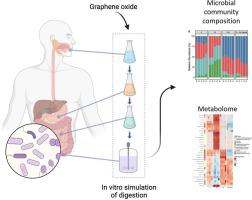NanoImpact ( IF 4.9 ) Pub Date : 2023-04-13 , DOI: 10.1016/j.impact.2023.100463 Sneha P Couvillion 1 , Robert E Danczak 1 , Xiaoqiong Cao 2 , Qin Yang 3 , Tharushi P Keerthisinghe 3 , Ryan S McClure 1 , Dimitrios Bitounis 2 , Meagan C Burnet 1 , Sarah J Fansler 1 , Rachel E Richardson 1 , Mingliang Fang 3 , Wei-Jun Qian 1 , Philip Demokritou 2 , Brian D Thrall 1

|
Graphene oxide (GO) nanomaterials have unique physicochemical properties that make them highly promising for biomedical, environmental, and agricultural applications.
There is growing interest in the use of GO and extensive in vitro and in vivo studies have been conducted to assess its nanotoxicity. Although it is known that GO can alter the composition of the gut microbiota in mice and zebrafish, studies on the potential impacts of GO on the human gut microbiome are largely lacking. This study addresses an important knowledge gap by investigating the impact of GO exposure- at low (25 mg/L) and high (250 mg/L) doses under both fed (nutrient rich) and fasted (nutrient deplete) conditions- on the gut microbial communitys' structure and function, using an in vitro model. This model includes simulated oral, gastric, small intestinal phase digestion of GO followed by incubation in a colon bioreactor. 16S rRNA amplicon sequencing revealed that GO exposure resulted in a restructuring of community composition. 25 mg/L GO induced a marked decrease in the Bacteroidota phylum and increased the ratio of Firmicutes to Bacteroidota (F/B). Untargeted metabolomics on the supernatants indicated that 25 mg/L GO impaired microbial utilization and metabolism of substrates (amino acids, carbohydrate metabolites) and reduced production of beneficial microbial metabolites such as 5-hydroxyindole-3-acetic acid and GABA. Exposure to 250 mg/L GO resulted in community composition and metabolome profiles that were very similar to the controls that lacked both GO and digestive enzymes. Differential abundance analyses revealed that 3 genera from the phylum Bacteroidota (Bacteroides, Dysgonomonas, and Parabacteroides) were more abundant after 250 mg/L GO exposure, irrespective of feed state. Integrative correlation network analysis indicated that the phylum Bacteroidota showed strong positive correlations to multiple microbial metabolites including GABA and 3-indoleacetic acid, are much larger number of correlations compared to other phyla. These results show that GO exposure has a significant impact on gut microbial community composition and metabolism at both low and high GO concentrations.
中文翻译:

氧化石墨烯暴露改变体外人体模型中的肠道微生物群落组成和代谢
氧化石墨烯 (GO) 纳米材料具有独特的物理化学特性,使其在生物医学、环境和农业应用中极具前景。
人们对 GO 的使用越来越感兴趣,并且已经进行了广泛的体外和体内研究以评估其纳米毒性。尽管已知 GO 可以改变小鼠和斑马鱼肠道微生物群的组成,但在很大程度上缺乏关于 GO 对人类肠道微生物群的潜在影响的研究。本研究通过调查低剂量 (25 mg/L) 和高 (250 mg/L) GO 暴露在进食(营养丰富)和禁食(营养耗尽)条件下对肠道的影响,解决了一个重要的知识缺口微生物群落的结构和功能,使用体外模型。该模型包括 GO 的模拟口腔、胃、小肠阶段消化,然后在结肠生物反应器中孵育。16S rRNA 扩增子测序显示 GO 暴露导致群落组成的重组。25 mg/L GO 诱导拟杆菌门显着减少,并增加厚壁菌门与拟杆菌门 (F/B) 的比例。上清液的非靶向代谢组学表明,25 mg/L GO 会损害微生物对底物(氨基酸、碳水化合物代谢物)的利用和代谢,并减少有益微生物代谢物(如 5-羟基吲哚-3-乙酸和 GABA)的产生。暴露于 250 mg/L GO 导致群落组成和代谢组谱与缺乏 GO 和消化酶的对照非常相似。拟杆菌属、单胞菌属和副杆菌属)在 250 mg/L GO 暴露后更丰富,与饲料状态无关。综合相关网络分析表明,拟杆菌门与包括 GABA 和 3-吲哚乙酸在内的多种微生物代谢物呈强正相关,与其他门相比,相关性要大得多。这些结果表明,GO 暴露对低和高 GO 浓度下的肠道微生物群落组成和代谢都有显着影响。



























 京公网安备 11010802027423号
京公网安备 11010802027423号